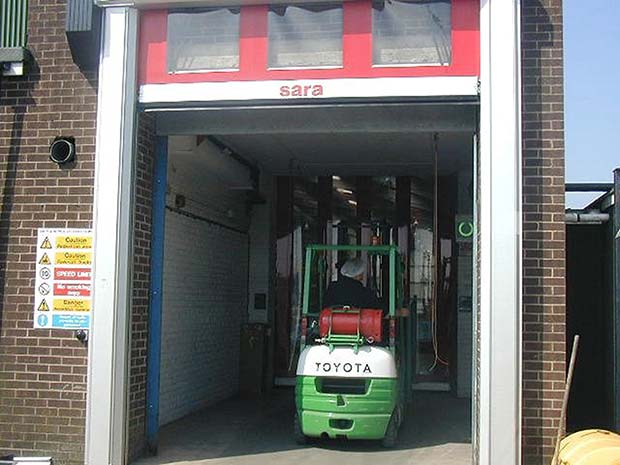An airlock famously saved the life of astronaut Tim Kopra. Here on Earth the same concept is used on loading bays when there is a compelling need to isolate the internal atmosphere from the outside. Alan Ryder, Areas Sales Manager with loading bay specialist sara LBS, recalls the fateful space walk and considers airlocks in his day-to-day life.

has a large high speed door at either end.
On the 16th January, 2016, astronauts Tim Kopra and Tim Peake made running repairs to the outside of the International Space Station. Korpa commented that there was some moisture building up in his helmet, and then a few minutes later said that it had grown into a small pool. Water continued to accumulate so that Kopra was in danger of drowning and we viewers were soon witnessing a real life-threatening emergency. Mission aborted; the astronauts hurried back to the airlock and despite their bulky spacesuits both had to squeeze inside.
TV presenters Dara Ó Briain and Prof Tim Cox were so anxious they could barely speak, and their commentary was reduced to disjoined thoughts and semi-coherent worries.
Once the outer door was closed and the airlock pressurised, the inner door was quickly opened and colleagues rushed to Kopra’s aid. Disaster was averted and we TV adventurers breathed a collective sigh of relief.
I work with airlocks quite frequently, but fortunately for my blood pressure, they are the sort you find in warehouse loading bays. My sort of airlock is large enough to accommodate a freight truck and has a large high speed door at either end.
The outer door opens and the truck reverses in; the outer door closes and the inner one opens so that loading/unloading can begin. The purpose of this sort of air lock is to provide the best possible seal between the outside atmosphere and the internal environment of the loading bay and the building it serves. Put in its simplest form, an air lock loading bay has doors at both ends which work in tandem so that the interior of the production hall or warehouse is always protected from the outside.
There is sometime confusion between ‘airlock’ doors and ‘interlocked’ doors – with many people assuming they are two different phrases for the same solutions. An airlock means two doors will work together, i.e. when the first door is passed through and closes behind the vehicle it hits its bottom limit and automatically sends a signal to the second door to open. This means that operatives generally do not need to perform a function to activate the doors. An interlock is where the controls of the doors are connected electronically allowing only one door to open at any one time. This means that activation controls are required within the airlock that the operatives activate once the first door has closed.
Of course the quality of the airlock package is reliant on the components, so it’s important doors are specified which match the requirements of the applications. The optimum solution will also allow free yet safe access for personnel and vehicles so that loading can be carried out quickly and efficiently. Because the operation is relatively complex compared to other loading bay equipment, the quality of all the individual components and the care taken with their installation is paramount. One component failure could stop production for a considerable time while the fault is traced and repaired.
Generally, airlocked loading bays include a dedicated personnel fire escape door, though it would typically be recommended that the air lock is not designated as an emergency egress route. However, to be on the safe side, the airlock’s high speed doors can have de-tensioning manual override systems or battery back-up units to assist in escape.
Naturally, airlocks add to the expense of building and maintaining loading bays, so are only specified where they are justified. We have already noted that they are excellent for heat/cool retention and for biosecurity, but they have a surprising number of other uses too.
For instance, they represent an extra layer of security deterrent, so can be installed at mints and vaults, where high value items are handled. Additionally, the natural delay in entry means CCTV installed in airlocks are be very effective in identifying intruders.
Airlocks are also very popular where goods being handled are foodstuffs, pharmaceuticals, medical equipment, dangerous chemicals or bio-hazards. Similarly, they are frequently found in countries that are either very hot or very cold and building interiors are air conditioned.
Whilst sara LBS airlocks are unlikely to save the lives of astronauts, they do provide a very useful service to specialist loading operations, and usually prove to be a very sound investment in the long run. sara LBS engineers are experience in the design and specification of such applications and can recommend suitable door combinations that offer a combination of robust security, speeds operation and energy efficient running.
SARA




Comments are closed.